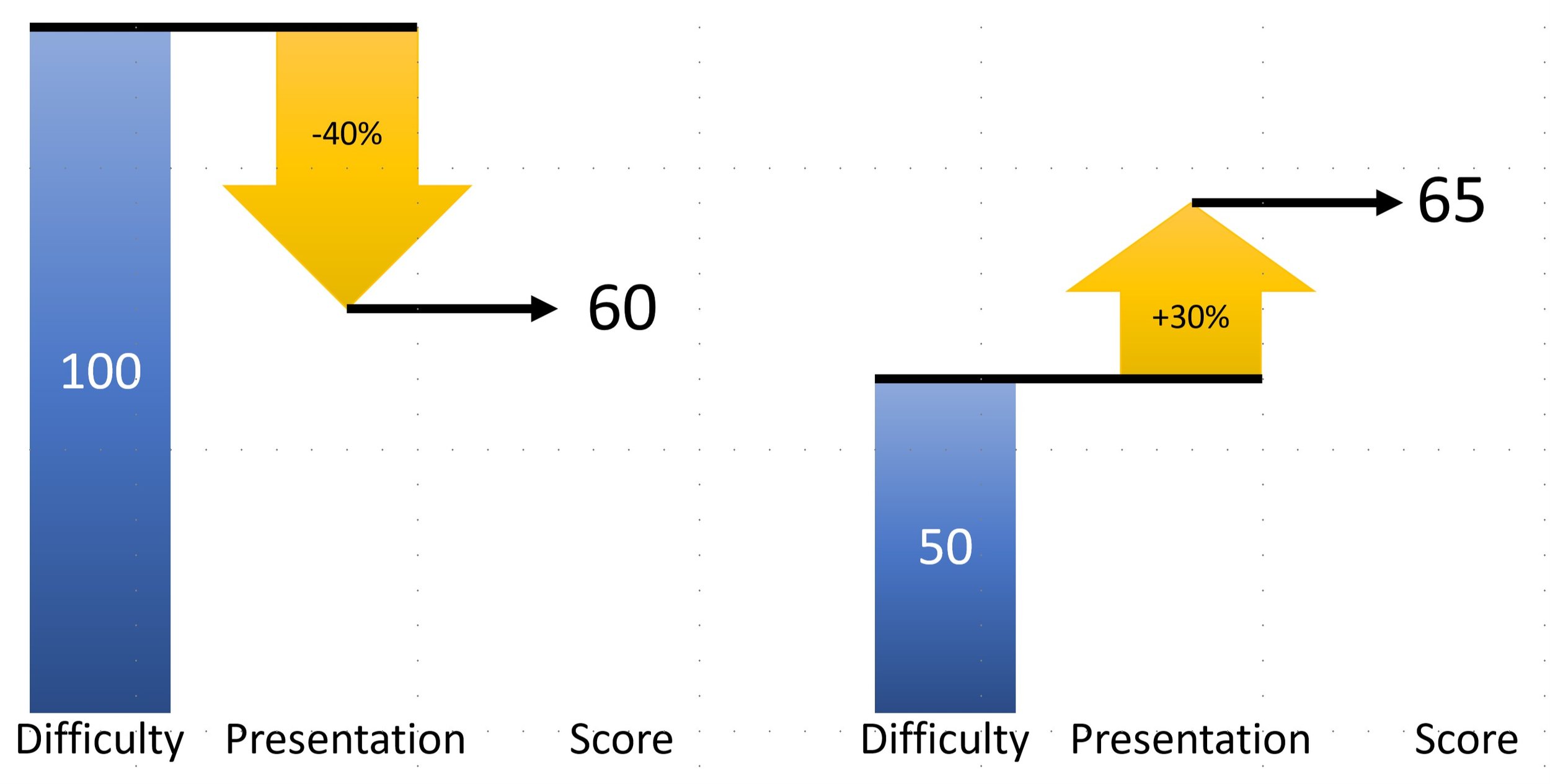Freestyle Score Calculations
A freestyle routine is evaluated in two main dimensions: difficulty and presentation. These aspects are separate to encourage athletes to create routines that push the boundaries of the skills in the sport, while also making the routines entertaining to watch for audiences inside and outside of our sport. We have had other posts on how these aspects of scores are calculated, and the goals for each. This post talks about how these scores are combined to provide proper weighting for each aspect. We’ll avoid the math as much as possible, but ultimately that’s how this all ends up getting done.
The IJRU Technical Congress believes that both aspects are important to a routine. That said, as many of you have commented, difficulty is the foundation of a routine. Our sport is built on a history of innovation and raising the bar and much of this is based on content. Since we are creating rules for competitive sport, it’s important to use the technical aspects of the routine as the foundation.
But that does not mean presentation is not important. For the growth of our sport, it is essential that our sport is accessible and attractive to those that know nothing about jump rope/rope skipping. Everyone in the sport today can tell the story of the first time they saw a jump rope/rope skipping show. Dry, engineered, technical routines are usually not memorable and do not attract people into the sport. The entertainment value of a routine is what creates a great first impression.
Incoming Rule Sets
Both FISAC and WJRF weighed difficult and presentation scoring, but in different ways.
FISAC, in its most recent rule set, used a ranking system in which all competitors in an event were ranked separately in difficulty and presentation. Then these ranks were used to pick the winner. The advantage of this approach is that it eliminated the need to create a balanced point system that weighed difficulty and presentation in the right proportion. The order of the results is all that mattered. The drawback of this approach is that it didn’t take into account the differences in scores between these ranks. For example, if two athletes ranked closely in presentation but had a large difference in difficulty, it may seem logical that this bigger difference in difficulty would give that athlete more credit, but under this system, being one point ahead is the same as being a hundred points ahead. While this is an extreme example, this approach didn’t seem ideal to us.
In the incoming WJRF rule set, the scoring calculations factor in target values for difficulty and presentation scores. This forces WJRF to create target values that will weigh both aspects in the desired proportion. Unfortunately, this is difficult to do for all levels of the sport and that bar moves as the sport advances. At lower levels of the sport, athletes do better with presentation but their content scores tend to be low, so presentation scores end up being weighed much more strongly. At the high end of the sport, very dense and difficult routines created high content scores that made presentation a very small factor. In some cases, athletes are incentivized to focus less on presentation and spend that time adding more difficult skills to their routines.
The Goal
We believe that an ideal system for combining content and presentation will:
Work for athletes competing in all levels of the sport.
Use difficulty as the basis for scoring – at high levels of the sport, you can’t win without a hard routine.
Reward for great presentation, and mark down for weak presentation.
Give presentation sufficient importance. Since we are using presentation to handle non-ideal aspects like repetitive skills, the presentation score has to have power to make major shifts in ranking at all levels of the sport (presentation must have ‘teeth’!).
Approach
We have moved to a calculation system that uses the difficulty score as the basis, then uses the presentation score to make a plus/minus adjustment within a percentage range. For example, an athlete that receives a content sore of 100, but a -40% adjustment based on weak presentation. That athlete would get a score of 60. Similarly, an athlete with a base difficulty score of 50 could get a +30% boost from presentation taking their final score to 65.
We are still working on the exact range and values, but at the beginning of a routine, an athlete will start with a 0% presentation adjustment, and through positive and negative marks on various elements from the presentation judges, that adjustment can end up a positive or negative percentage value.
The benefit of this approach is that it meets our goal of a formula that works at all levels of the sport. Since the adjustment is a percentage, it works well on easy routines and hard ones. It uses difficulty as the base, so even with an extremely entertaining routine, there’s a hard upper limit no matter how well an easy routine can score.
Conclusion
This approach also gives presentation weight at all levels. A championship routine with great skills can be surpassed by a slightly easier routine with great presentation.
Compared to the WJRF system, this is more consistent at all levels of the sport and will not need to be adjusted as much as difficulty increases.
Compared to the FISAC system, this rewards athletes who are well above other athletes in difficulty and presentation while retaining a balance between both aspects.
We are still evaluating different approaches to deductions (required elements and misses)
Community Commentary
Winter festivities are around the corner and December is a stressful month. We have read all your feedback and discussed it, but unfortunately we haven’t had time to write responses yet. To make sure we give you the best responses possible we will publish this weeks community commentary separately.
Survey not loading? Click here

